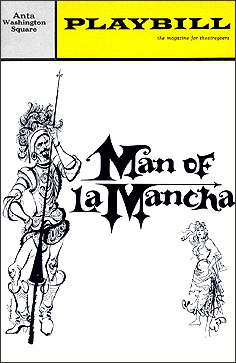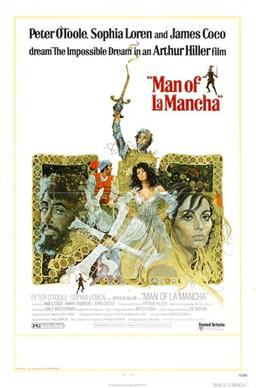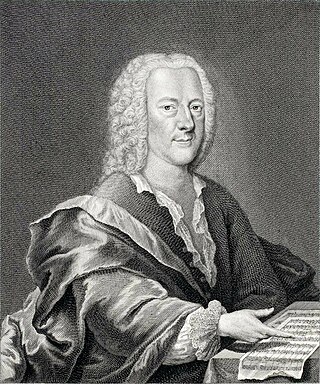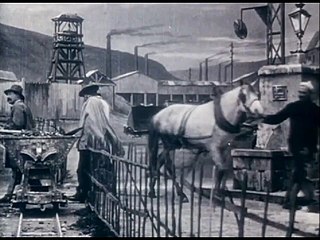Related Research Articles

Don Quixote, the full title being The Ingenious Gentleman Don Quixote of La Mancha, is a Spanish novel by Miguel de Cervantes. It was originally published in two parts, in 1605 and 1615. Considered a founding work of Western literature, it is often said to be the first modern novel. Don Quixote is also one of the most-translated books in the world and one of the best-selling novels of all time.

Man of La Mancha is a 1965 musical with a book by Dale Wasserman, music by Mitch Leigh, and lyrics by Joe Darion. It is adapted from Wasserman's non-musical 1959 teleplay I, Don Quixote, which was in turn inspired by Miguel de Cervantes and his 17th-century novel Don Quixote. It tells the story of the "mad" knight Don Quixote as a play within a play, performed by Cervantes and his fellow prisoners as he awaits a hearing with the Spanish Inquisition. The work is not and does not pretend to be a faithful rendition of either Cervantes' life or Don Quixote. Wasserman complained repeatedly about people taking the work as a musical version of Don Quixote.

Dulcinea del Toboso is a fictional character who is unseen in Miguel de Cervantes' novel Don Quixote. Don Quixote believes he must have a lady, under the mistaken view that chivalry requires it. As he does not have one, he invents her, making her the very model of female perfection: "[h]er name is Dulcinea, her country El Toboso, a village of La Mancha, her rank must be at least that of a princess, since she is my queen and lady, and her beauty superhuman, since all the impossible and fanciful attributes of beauty which the poets apply to their ladies are verified in her; for her hairs are gold, her forehead Elysian fields, her eyebrows rainbows, her eyes suns, her cheeks roses, her lips coral, her teeth pearls, her neck alabaster, her bosom marble, her hands ivory, her fairness snow, and what modesty conceals from sight such, I think and imagine, as rational reflection can only extol, not compare".

Lost in La Mancha is a 2002 documentary film about Terry Gilliam's first attempt to make The Man Who Killed Don Quixote, a film adaptation of the 1605/1615 novel Don Quixote by Miguel de Cervantes. The documentary was shot in 2000 during pre-production and filming and it was intended as a "making-of" documentary for the film. However, Gilliam's failure to complete his film resulted in the documentary filmmakers retitling their work as Lost in la Mancha and releasing it independently.

Sancho Panza is a fictional character in the novel Don Quixote written by Spanish author Miguel de Cervantes Saavedra in 1605. Sancho acts as squire to Don Quixote and provides comments throughout the novel, known as sanchismos, that are a combination of broad humour, ironic Spanish proverbs, and earthy wit. "Panza" in Spanish means "belly".

Don Quichotte is an opera in five acts by Jules Massenet to a French libretto by Henri Caïn. It was first performed on 19 February 1910 at the Opéra de Monte-Carlo.
Don Quixote, fully El ingenioso hidalgo Don Quijote de la Mancha, is a classic novel by Miguel de Cervantes Saavedra, originally published in two parts, in 1605 and 1615.

Man of La Mancha is a 1972 film adaptation of the Broadway musical Man of La Mancha by Dale Wasserman, with music by Mitch Leigh and lyrics by Joe Darion. The musical was suggested by the classic novel Don Quixote by Miguel de Cervantes, but more directly based on Wasserman's 1959 non-musical television play I, Don Quixote, which combines a semi-fictional episode from the life of Cervantes with scenes from his novel.
Don Quixote (1933) is a British-French film adaptation of the classic Miguel de Cervantes novel, directed by Georg Wilhelm Pabst, starring the famous operatic bass Feodor Chaliapin. Although the film stars Chaliapin, it is not an opera. However, he does sing four songs in it. It is the first sound film version of the Spanish classic. The supporting cast in the English version includes George Robey, René Donnio, Miles Mander, Lydia Sherwood, Renée Valliers, and Emily Fitzroy. The film was made in three versions—French, English, and German—with Chaliapin starring in all three versions.

Don Quixote or Don Quixote de la Mancha is the first sound film version in Spanish of the great classic novel by Miguel de Cervantes Saavedra. It was directed and adapted by Rafael Gil and released in 1947. A huge undertaking for Spanish cinema in its day, it was the longest film version of the novel up to that time, and very likely the most faithful, reverently following the book in its dialogue and order of episodes, unlike G.W. Pabst's 1933 version and the later Russian film version, which scrambled up the order of the adventures as many film versions do. Characters such as Cardenio, Dorotea, and Don Fernando, which are usually omitted because their respective subplots have little to do with the main body of the novel, were kept in this film.
Don Quixote is an unfinished film project written, co-produced and directed by Orson Welles. Principal photography took place between 1957 and 1969. Test footage was filmed as early as 1955, second-unit photography was done as late as 1972, and Welles was working on the film intermittently until his death in 1985. The film was eventually edited by Jesús Franco and was released in 1992, to mixed reviews.

Donkey Xote is a 2007 animated children's film produced by Lumiq Studios. A co-production between Spain and Italy, the film is directed by José Pozo and written by Angel Pariente, based on the Miguel de Cervantes novel Don Quixote, and features the voices of Andreu Buenafuente, David Fernández, Sonia Ferrer and José Luis Gil. The film has gained notoriety as a mockbuster as the lead character Rucio bears an intentional resemblance to Donkey from the Shrek film series, along with the poster and trailer having the tagline "From the producers who saw Shrek".

Don Quichotte auf der Hochzeit des Comacho, TVWV 21:32, is a one-act comic serenata by Georg Philipp Telemann. The libretto by the student poet Daniel Schiebeler is based on chapter 20 of volume 2 of Cervantes's novel Don Quixote. The opera premiered on 5 November 1761 in Hamburg. When first performed, it was given the title: Don Quichotte auf der Hochzeit des Comacho; later it was also known as Don Quixote der Löwenritter.
La Toile d'araignée merveilleuse, released in the United States as Incident from Don Quixote and in Britain as Magic Armour, and also known as The Marvelous Cobweb and as Aventures de Don Quichotte, was a 1908 French short silent film directed by Georges Méliès, inspired by Miguel de Cervantes's Don Quixote.

Quichotte is a 2019 novel by Salman Rushdie. It is his fourteenth novel, published on 29 August 2019 by Jonathan Cape in the United Kingdom and Penguin Books India in India. It was published in the United States on 3 September 2019 by Random House. Inspired by Miguel de Cervantes's classic novel Don Quixote, Quichotte is a metafiction that tells the story of an addled Indian-American man who travels across America in pursuit of a celebrity television host with whom he has become obsessed.
William Tell is a 1903 French silent short film directed by Lucien Nonguet and distributed in France by Pathé Frères. The original French title is Guillaume Tell. It is the first film adaptation of the eponymous play by Friedrich Schiller.

Au pays noir is a 1905 French silent short film directed by Ferdinand Zecca and Lucien Nonguet, and distributed in English-speaking countries under the titles In the Mining District, Down in the Coal Mines and Tragedy in a Coal Mine. The film is based on Emile Zola's novel Germinal.
The Game-Keeper's Son, is a 1906 French silent short film directed by Alice Guy-Blaché.
Madame's cravings, is a 1906 French silent short film produced by the Gaumont Film Company and directed by Alice Guy-Blaché.
References
- 1 2 Review and link to watch the film: "Don Quichotte (1903)". A Cinema History. Blogspot. Archived from the original on 31 January 2023. Retrieved 21 February 2021.
- 1 2 3 "Aventures de Don Quichotte". Fondation Jérôme Sédoux-Pathé (in French). Archived from the original on 29 October 2020. Retrieved 21 February 2021.
- ↑ "Don Quichotte (Short 1903) - Release info". Internet Movie Database.
- 1 2 Richard Abel, The Cine Goes to Town: French Cinema, 1896-1914, University of California Press, 1998, pp. 84-85.